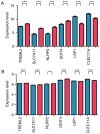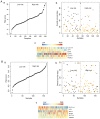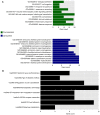A novel scoring system for acute myeloid leukemia risk assessment based on the expression levels of six genes
- PMID: 29956722
- PMCID: PMC6089755
- DOI: 10.3892/ijmm.2018.3739
A novel scoring system for acute myeloid leukemia risk assessment based on the expression levels of six genes
Abstract
Acute myeloid leukemia (AML) is the most common type of acute leukemia and is a heterogeneous clonal disorder. At present, the pathogenesis of AML and potential methods to effectively prevent AML have become areas of interest in research. In the present study, two messenger ribonucleic acid sequencing datasets of patients with AML were downloaded from the Cancer Genome Atlas and Gene Expression Omnibus databases. The differentially expressed genes (DEGs) of the poor and good prognosis groups were screened using the Linear Models for Microarray Data package, and the prognosis‑related genes were screened using univariate Cox regression analysis. A total of 206 significant DEGs were identified. Following univariate and multivariate Cox regression analysis, 14 genes significantly associated with prognosis were screened and six of these genes, including triggering receptor expressed on myeloid cells 2 (TREML2), cysteine‑glutamate transporter (SLC7A11), NACHT, LRR, and PYD domains‑containing protein 2 (NLRP2), DNA damage‑inducible transcript 4 protein (DDIT4), lymphocyte‑specific protein 1 (LSP1) and C‑type lectin domain family 11 member A (CLEC11A), were used to construct model equations for risk assessment. The prognostic scoring system was used to evaluate risk for each patient, and the results showed that patients in the low‑risk group had a longer survival time, compared with those in the high‑risk group (P=9.59e‑06 for the training dataset and P=0.00543 for the validation dataset). A total of eight main Kyoto Encyclopedia of Genes and Genomes pathways were identified, the top three of which were hematopoietic cell lineage, focal adhesion, and regulation of actin cytoskeleton. Taken together, the results showed that the scoring system established in the present study was credible and that the six genes were identified, which were significantly associated with the risk assessment of AML, offer potential as prognostic biomarkers. These findings may provide clues for further clarifying the pathogenesis of AML.
Figures








Similar articles
-
A Novel Prognostic Risk-Scoring Model Based on RAS Gene-Associated Cluster in Pediatric Acute Myeloid Leukemia.Cancer Med. 2025 Mar;14(5):e70716. doi: 10.1002/cam4.70716. Cancer Med. 2025. PMID: 40062727 Free PMC article.
-
Construction of prognostic risk prediction model based on high-throughput sequencing expression profile data in childhood acute myeloid leukemia.Blood Cells Mol Dis. 2019 Jul;77:43-50. doi: 10.1016/j.bcmd.2019.03.008. Epub 2019 Mar 28. Blood Cells Mol Dis. 2019. PMID: 30954792
-
A novel scoring system for gastric cancer risk assessment based on the expression of three CLIP4 DNA methylation-associated genes.Int J Oncol. 2018 Aug;53(2):633-643. doi: 10.3892/ijo.2018.4433. Epub 2018 Jun 6. Int J Oncol. 2018. PMID: 29901187 Free PMC article.
-
Development and validation of a promising 5-gene prognostic model for pediatric acute myeloid leukemia.Mol Biomed. 2024 Jan 2;5(1):1. doi: 10.1186/s43556-023-00162-y. Mol Biomed. 2024. PMID: 38163849 Free PMC article.
-
A decade of genome-wide gene expression profiling in acute myeloid leukemia: flashback and prospects.Blood. 2009 Jan 8;113(2):291-8. doi: 10.1182/blood-2008-04-153239. Epub 2008 Aug 14. Blood. 2009. PMID: 18703705 Free PMC article. Review.
Cited by
-
Up-regulation of DDIT4 predicts poor prognosis in acute myeloid leukaemia.J Cell Mol Med. 2020 Jan;24(1):1067-1075. doi: 10.1111/jcmm.14831. Epub 2019 Nov 21. J Cell Mol Med. 2020. PMID: 31755224 Free PMC article.
-
DDIT4 overexpression associates with poor prognosis in lung adenocarcinoma.J Cancer. 2021 Sep 3;12(21):6422-6428. doi: 10.7150/jca.60118. eCollection 2021. J Cancer. 2021. PMID: 34659532 Free PMC article.
-
Super-enhancer-associated gene CAPG promotes AML progression.Commun Biol. 2023 Jun 9;6(1):622. doi: 10.1038/s42003-023-04973-1. Commun Biol. 2023. PMID: 37296281 Free PMC article.
-
High Expression of CLEC11A Predicts Favorable Prognosis in Acute Myeloid Leukemia.Front Oncol. 2021 Mar 2;11:608932. doi: 10.3389/fonc.2021.608932. eCollection 2021. Front Oncol. 2021. PMID: 33747924 Free PMC article.
-
Construction of a 14-lncRNA risk score system predicting survival of children with acute myelocytic leukemia.Exp Ther Med. 2020 Aug;20(2):1521-1531. doi: 10.3892/etm.2020.8846. Epub 2020 Jun 5. Exp Ther Med. 2020. PMID: 32742384 Free PMC article.
References
MeSH terms
LinkOut - more resources
Full Text Sources
Other Literature Sources
Medical
Research Materials
Miscellaneous

